Exploring Oceanography: The Depths of Marine Science
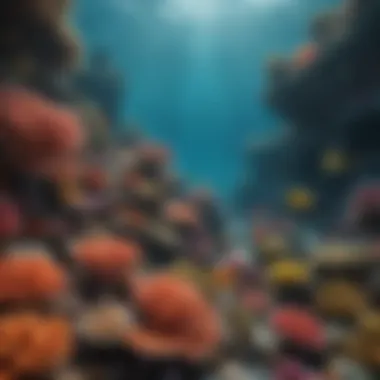
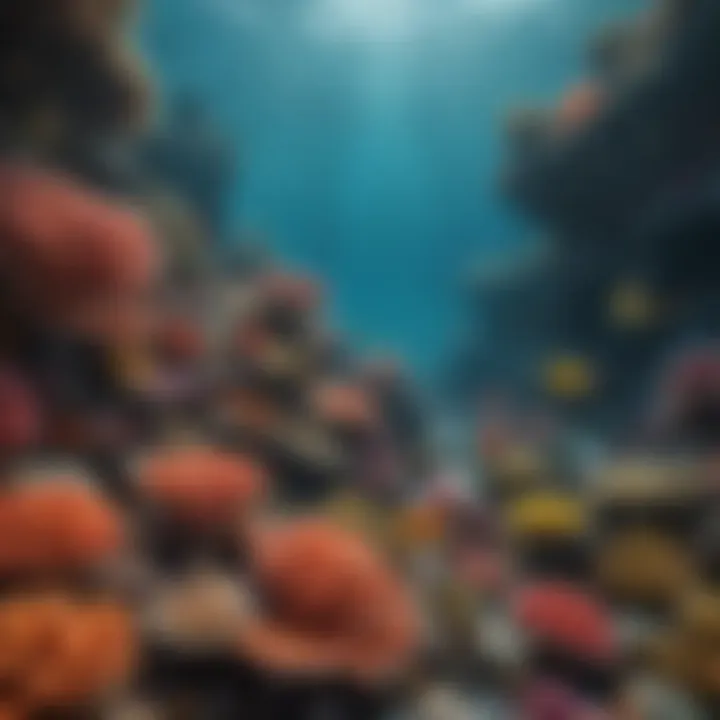
Intro
The ocean, a vast and intricate world, covers more than 70% of our planet's surface. Beneath its surface lies a diversity of life and phenomena that many of us barely scratch the surface of understanding. Oceanography intersects with various fields, allowing us to gain insight into how our oceans operate and influence global systems. This is particularly relevant today, as our increasing awareness of climate change and its effects on marine ecosystems presents a critical crossroads for humanity's future.
Studying oceanography isn't just for scientists; it’s important for surfers, paddleboarders, kitesurfers, instructors, and those who love the waves. Understanding ocean currents, tides, and marine biodiversity enhances not only our appreciation of the ocean but also our responsibility toward conservation.
Gear Essentials
When you're out there on the water, having the right gear is crucial. Whether it’s surfing, paddleboarding, or kitesurfing, the right equipment can make all the difference. Below, we explore the essentials that every ocean enthusiast should consider when gearing up for an adventure.
Key Gear Picks
- Surfboards:
- Paddleboards:
- Kites:
- Shortboards: Great for high-performance surfing and agility. Models like the Lost Rocket excel in shorter, steeper waves.
- Funboards: A hybrid option for those transitioning from longboards, offering versatility in various wave conditions.
- All-around SUPs: These are ideal for beginners and can handle different water conditions. The Red Paddle Co. Ride is a top choice.
- Touring SUPs: Great for longer distances, built for speed and stability.
- One Pump Kites: Such as the Duotone Neo, which simplifies inflation and deflation for ease of use.
- Foil Kites: For those looking to glide over the water rather than surf it.
Maintenance and Care Tips for Gear
Caring for your ocean gear can prolong its life and enhance your performance. Here are some handy tips:
- Rinse with Freshwater After Each Use: Saltwater can corrode equipment, especially surfboards and kites.
- Store Properly: Keep your gear in a cool, dry place, away from direct sunlight to prevent damage.
- Inspect Regularly: Check for wear and tear, especially on kites' seams and surfboard fins.
Understanding Ocean Currents
The world of oceanography goes beyond gear. Understanding ocean currents, for instance, is essential for anyone venturing onto the open water. These currents affect everything from weather patterns to marine migration.
Ocean Current Dynamics
- Surface Currents: Formed primarily by wind patterns, surface currents distribute heat across the globe.
- Deep-Water Currents: Influenced by water density and salinity, these currents play a key role in regulating the Earth's climate.
"Ocean currents are nature's way of regulating the planet’s temperature and distributing nutrients vital for marine life. Learning their patterns can enhance our understanding of the conditions in which ocean enthusiasts operate."
Finale
The ocean is more than a playground. It is a complex and vital ecosystem that deserves our understanding and protection. From selecting the right gear to comprehending the underlying science of ocean currents, everything plays a role in ensuring a safe and enjoyable experience on the water.
By diving deeper into oceanography, we equip ourselves with the knowledge needed to make responsible decisions and foster a sustainable relationship with our oceans.
Prelims to Oceanography
Oceanography is not just a branch of science; it's a crucial key to understanding our planet's health and future. With the ocean covering roughly 71% of the Earth's surface, comprehending its processes is key for anyone who enjoys outdoor water activities like surfing, paddleboarding, or kitesurfing. This field encompasses the study of various oceanic components and how they interact with each other and with the atmosphere. For enthusiasts and professionals alike, an in-depth grasp of oceanography can enhance appreciation for the marine environment and inform practices that promote sustainability and thrill in aquatic sports.
Defining Oceanography
Simply put, oceanography is the scientific exploration of the ocean. It delves into the physical, chemical, biological, and geological interactions within ocean waters. Think of it as a comprehensive examination of everything from the microscopic plankton to the towering sea cliffs. Acknowledging how these components function and come together offers valuable insights not just for scientific communities but also for recreational enthusiasts.
Various terms crop up in conversations about oceanography, like salinity, currents, and thermoclines. It's not all complex jargon though; even a casual surfer might notice the differences in water temperature or salinity while out in the waves. For those who take to the water, knowledge of these elements can lead to better decision-making while navigating the tides, thus enriching the overall experience.
Historical Context of the Discipline
Oceanography's roots trace back to the ancient civilizations, where mariners relied on their observations about the ocean's nature. The Greeks, for instance, set the stage with early maps and theories about ocean currents. Fast forward to the fifteenth century, and you have explorers like Ferdinand Magellan and Sir Francis Drake, whose voyages further ignited scientific curiosity about marine realms.
However, it wasn't until the mid-19th century that oceanography began to evolve into a formal discipline. Notably, the HMS Challenger expedition (1872-1876) marked a pivotal moment in ocean research, enabling scientists to gather data from unprecedented depths. The ocean that these early explorers encountered was not just a vast body of water; it became a canvas reflecting geophysical processes and biological wonders.
By piecing together observations and theories from various time periods, modern oceanography has burgeoned into a diverse field. Today, oceanographers use cutting-edge technology like autonomous underwater vehicles and satellite imaging to probe our oceans' mysteries. This historical backdrop is essential, as it highlights how far we have come and how vital our oceans are to life on Earth.
"The ocean stirs the heart, inspires the imagination, and brings eternal joy to the soul." - Wyland
For anyone looking to understand the complexities of ocean systems, recognizing the historical context underlines the importance of marine studies today. Ultimately, our relationship with the ocean is an evolving narrative, one that aligns well with activities that thrive in marine environments.
Major Branches of Oceanography
Oceanography is a vast discipline that can often overwhelm those who are not familiar with its intricacies. Understanding its major branches is crucial because each area provides a lens through which we can grasp the complexities of marine environments and their significance. From physical forces to biological interactions and geological formations, the various branches of oceanography contribute to our overall comprehension of the ocean's role on Earth.
Physical Oceanography
Interactions between climate and ocean
The relationship between climate and ocean is an intricate dance, where each influences the other's rhythm. This connection significantly shapes global weather patterns. For instance, phenomena like El Niño and La Niña, which start in the ocean, ripple through the atmosphere, affecting weather conditions far beyond coastal areas. Understanding these interactions helps in predicting extreme weather events, which can save lives and mitigate disaster impacts. The ocean acts as a carbon sink, absorbing carbon dioxide from the atmosphere, and this characteristic makes it pivotal in discussions about climate change.
The ocean is vital for regulating the planet's climate, acting both as a buffer and a source of climate change effects.
However, the flip side is that climate itself can alter ocean temperatures and currents, which can disrupt marine ecosystems. Monitoring these changes is essential for maintaining ecosystem balance and ensuring sustainable marine environments, making it a fundamental aspect of oceanography.
The study of waves and tides
Waves and tides may seem like simple phenomena, but they are critical in understanding coastal processes and sediment transport. These natural movements significantly affect beach morphology and ecosystems. Understanding wave dynamics lets surfers appreciate the wave's behavior, predict surf conditions, and gauge safety levels when hitting the water.
The unique feature about waves is how they interact with the shore, creating both constructive and destructive processes on coastlines. While they can shape beaches, they can also lead to erosion, posing consequences for coastal communities. Analyzing these tidal patterns and wave mechanics also helps mitigate coastal flooding and manage land use around beaches.
Ocean circulation patterns
Ocean currents are like highways of water, guiding everything from climate to marine life distribution. These oceanic highways transport heat and nutrients across vast distances, influencing weather and climate in regions that may be hundreds of miles away from the ocean itself. For surfers, understanding how these currents work can be the difference between a good day on the water and a challenging one.
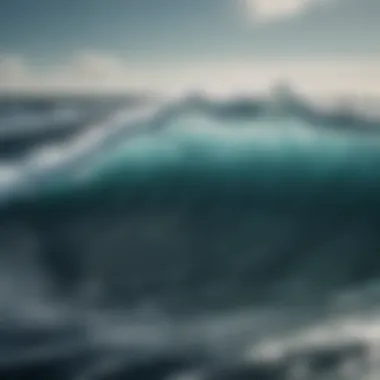

The uniqueness of ocean circulation patterns lies in their complexity. They can form large gyres or mini-currents that significantly affect local environments and weather systems. Also, these patterns can change due to various factors, like climate shifts. This variability can have profound implications on biodiversity and fishing stocks, making understanding them essential for sustainable resource management.
Chemical Oceanography
Ocean chemistry and its significance
Ocean chemistry forms the fundamental bedrock of all marine sciences. It involves understanding the composition and behavior of seawater, including essential ions and compounds. The balance of these chemicals directly affects marine organisms and ecosystems. For instance, the pH level of ocean water is crucial; small shifts can impact everything from coral reefs to plankton survival.
This branch highlights significant connections, such as nutrient cycling and how they impact overall ocean health. Thus, it plays a central role in discussions about environmental sustainability. When we talk about conservation, we must include the chemical interactions within these systems, which ultimately influence biodiversity.
Role of nutrients in marine ecosystems
Nutrients like nitrogen and phosphorus are vital for marine life as they drive primary productivity. These elements influence food webs, supporting everything from tiny plankton to massive whales. A lack of or excess nutrients can lead to problems: too few can starve ecosystems, while too many can cause harmful algal blooms, depleting oxygen and harming marine life.
The centralized nature of this aspect makes it both beneficial and critical in sustaining marine systems. Understanding this helps us strategize not just local ecosystem management but also larger marine conservation efforts—showing how interconnected our understanding of the ocean can be.
Impact of pollution on ocean chemistry
Pollution has become a nasty word across many disciplines, especially in oceanography. Chemicals, plastic waste, and oil spills transform ocean chemistry, harming marine life and degrading habitats. These pollutants can lead to a decline in species diversity and health, impacting food chains and local economies reliant on the ocean.
This negative feature of pollution makes it a popular yet disheartening topic within ocean discussions. Addressing these influences is crucial for repairing and maintaining ocean health. An examination of the ways pollution alters chemical balances in ocean systems underscores the need for global efforts in waste reduction and environmental policies.
Biological Oceanography
Marine biodiversity and ecosystems
The richness of marine biodiversity is stunning. Each species, from the tiniest microbe to the largest whale, plays a role in maintaining ecological balance. Biodiversity contributes directly to the resilience of marine systems. For instance, a diverse coral reef can better withstand stressors like temperature changes compared to a monoculture.
The key characteristic here is how intricate relationships within ecosystems work. These ecosystems provide services, such as fishing and tourism, that many coastal communities depend on. Understanding these relationships is essential for those who rely on ocean resources, aligning with sustainable practices that benefit الجميع.
Plankton: The foundation of the marine food web
Plankton might be tiny, but they are giants in their environmental role. These microscopic organisms are the base of the marine food web, feeding countless species, from small fish to whale sharks. Therefore, understanding plankton dynamics is critical for any discussions about marine health.
This foundational aspect of marine life is vital, as any disruptions in plankton populations can cascade through the food web, affecting larger predators. Their observation and data collection can alert researchers to wider ecological changes, proving their importance in understanding ocean health.
Impact of overfishing on marine life
Overfishing is like trying to cut a cake where every piece is important. Removing too much from the ocean can lead to dramatic shifts in populations. This unregulated extraction not only impacts fish stock levels but also disrupts ecological relationships. Species that depend on affected fish as prey or competitors can suffer, ultimately changing entire ecosystems.
The unique feature of this topic is its immediacy; the effects are often visible in relatively short time frames. Addressing overfishing is a pressing matter for ocean health and requires concerted efforts by policymakers and fishermen alike to find a balance that supports marine life and livelihoods.
Geological Oceanography
Seafloor geology and sedimentation
The ocean floor is like the basement of a house, often overlooked but crucial for structural integrity. Studying seafloor geology helps scientists understand sedimentation processes that can influence marine life and coastal systems. Areas with high sedimentation can experience shifts in habitat or even loss of marine species if not managed.
This characteristic makes it a worth-discussing topic as it ties back to how changes on the seafloor can influence everything above it, including current flows and marine ecosystems. Understanding sedimentation patterns allows for better predictive modeling concerning future changes in marine environments.
Plate tectonics and ocean formation
The theory of plate tectonics gives insights into how oceans are formed and shaped. Movements of these tectonic plates facilitate the creation of ocean basins, seafloor spreading, and even volcanic activity under the sea. This fundamental knowledge helps explain many geological phenomena, including earthquakes and tsunamis, which are also critical for coastal safety.
The importance of plate tectonics stretches beyond geological phenomena; it illustrates how interconnected our planet's systems are. This understanding is paramount not just for scientists but also for public awareness about risks that coastal communities may face against natural disasters.
Implications of underwater geological processes
Underwater geological processes are not just a curiosity; they can have direct implications for marine life and human activities. These natural events can create habitats, alter sea levels, and even affect ocean currents. For example, volcanic activity can create new landforms that serve as habitats for marine species but also as a part of the oceanic ecosystem.
The unique aspect here is how these geological processes can change over both short and long time scales. Understanding these implications is fundamental to formulating strategies for ocean conservation and management, ensuring we can preserve our seas for future generations.
Importance of Oceanography for Society
Oceanography is not just an academic pursuit; it embodies a pressing necessity for our society. Understanding the interplay between the ocean and human activities is fundamental to address the looming challenges we face. The ocean covers more than 70% of our planet's surface, and its health directly impacts climate, economies, and biodiversity. With the advent of more industrialization and urban development, it’s imperative to understand how our actions affect this vast body of water.
Understanding Climate Change
Role of oceans in carbon sequestration
The oceans serve as significant carbon sinks, absorbing roughly 25% of the carbon dioxide produced by human activities. This aspect of ocean function is critical in mitigating the effects of climate change. By storing carbon over long periods, oceans help temper the greenhouse gases that would otherwise significantly increase global temperatures. One of the unique features of this natural process is the ability of marine plants, like phytoplankton, to utilize sunlight and carbon dioxide for photosynthesis. This characteristic is crucial, as it not only contributes to oxygen production but also has a notable cooling effect on the planet.
However, there's a double-edged sword here. As the oceans absorb more CO2, they become more acidic, which can be detrimental to marine life, particularly for coral reefs and shellfish. This balance—between helping to reduce carbon in our atmosphere and facing ecological harm—is something our article highlights.
Effects on global weather patterns
Ocean currents play a significant role in influencing weather patterns globally. Warm and cold water masses interact to create complex weather systems. For instance, the Gulf Stream transports warm water from the Gulf of Mexico to the North Atlantic, influencing climate and weather patterns across Europe and North America. The concept of teleconnections illustrates this connection effectively, showing how certain changes in ocean temperatures can ripple through the atmosphere, affecting weather far from their origin.
This intersection of ocean and atmosphere showcases the ocean's vital role in regulating climate, making it a critical point in assessing climate change impacts. However, as weather patterns become increasingly erratic due to climate change, predicting these shifts gets tricky, and it can lead to extreme weather events, which poses a real concern.
Impacts of rising sea levels
Rising sea levels, a direct result of polar ice melt and thermal expansion due to global warming, pose a significant threat to coastal communities. The unique feature here is that it not only involves gradual increases but can also lead to sudden flooding events during storms. This is becoming increasingly common, leading to serious implications for real estate, local economies, and human displacement.
As more inhabitants live in coastal areas, the relevance of this issue becomes stark. It is essential for communities to adapt and prepare for the reality of rising seas, making this concern vital for urban planning and disaster preparedness strategies. The article dives deep into the consequences of these phenomena, bringing awareness to these pressing issues.
Sustainable Resource Management
The role of fisheries in ocean health
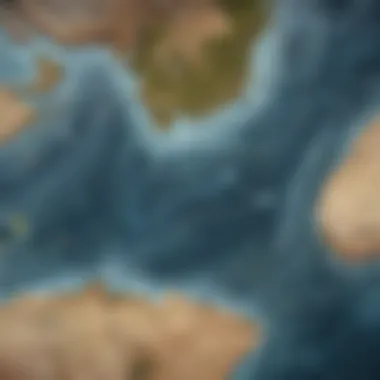
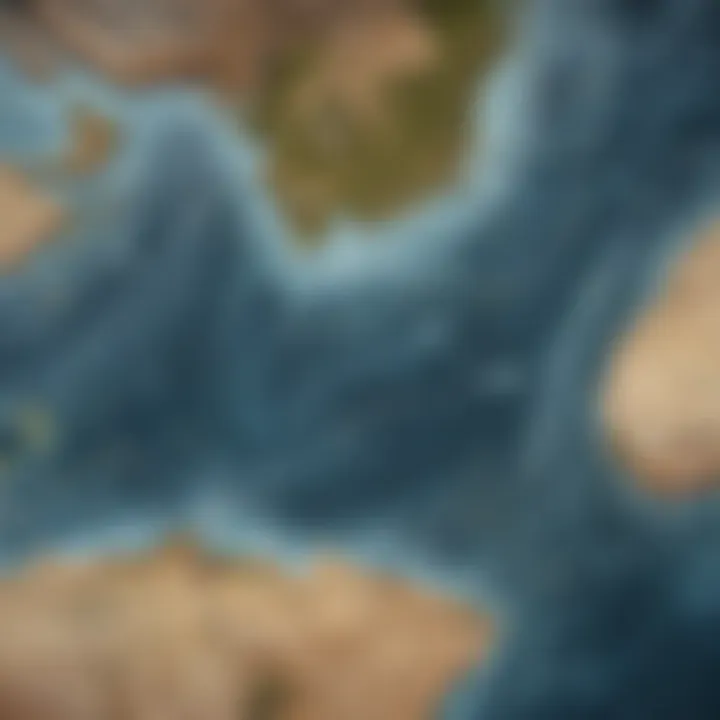
Fisheries have a dual role: they provide food and nutrition for billions but can also lead to the over-exploitation of marine stocks if not managed sustainably. The health of fisheries is tightly interwoven with the ecosystem's overall integrity. Responsible fishing practices promote the recovery of fish populations, directly impacting ocean biodiversity. The phrase "catch and release" springs to mind; it’s a practice to conserve fish stocks. Sustainable fisheries management practices contribute greatly to marine health by ensuring that species are not being harvested faster than they can reproduce.
But it’s a delicate balance. Overfishing creates a cascading effect throughout the marine food web, disrupting the stability of entire ecosystems. This highlights the complexity of fisheries management, making it pivotal for the overall health of oceans and societies dependent on them.
Marine protected areas and their significance
Marine Protected Areas (MPAs) serve as sanctuaries for marine life, allowing ecosystems to thrive without the pressures of human activity. The purpose of MPAs is to conserve biodiversity and ecosystem services, which are essential for a healthy ocean. They create zones where fishing, pollution, and habitat degradation are either prohibited or controlled, giving the environment a chance to recover and restoring natural balance. The key characteristic of MPAs is that they ensure a portion of the ocean remains untouched by human interference.
However, establishing MPAs can be contentious. There’s always a risk of pushback from local fishermen and industries that rely on the ocean for their livelihoods. Balancing the needs of conservation and local economies is crucial to the successful implementation of these protected areas. Our article underscores the necessity of engaging local communities in the planning and management of MPAs for them to be effective.
Balancing extraction and conservation
The extraction of resources from the ocean, whether through fishing, oil drilling, or other means, must be balanced with conservation efforts to ensure long-term viability of marine ecosystems. Sustainable management is where eyes ought to be focused. If done right, extraction practices can benefit local economies while maintaining the health of ocean ecosystems.
The concept of sustainable development is central here. Striking a balance between using resources and conserving ocean health is complex but necessary. Our article discusses innovative practices to achieve this, and while challenges exist, the importance of collaboration between scientists, policymakers, and stakeholders cannot be overstated.
Marine Pollution and Human Impact
Plastic pollution and its effects
Plastic pollution stands as one of the most pressing environmental challenges faced by the oceans today. With millions of tons of plastic waste finding its way into the ocean each year, the impact is devastating for marine life. Sea turtles, seals, and seabirds often mistake plastic for food, leading to injury or death. The article elaborates on this profound issue, spotlighting the long-lasting presence of plastic debris in ocean waters.
The characteristic here is how pervasive and insidious plastic pollution has become. Unlike organic materials, plastics degrade very slowly, leading to lasting environmental harm. The perception of plastic as disposable has contributed significantly to this crisis, making awareness and education crucial components of combating plastic waste.
Oil spills: Causes and consequences
Oil spills are another critical aspect of marine pollution, often resulting from accidents involving oil tankers or drilling rigs. The consequences of such spills are catastrophic for marine ecosystems. Immediate effects include the destruction of marine habitats and long-term repercussions involve toxins entering the food web. The article addresses how the aftermath of spills impacts local economies reliant on healthy oceans.
The unique challenge with oil spills is their unpredictable nature, and while containment methods have improved, prevention remains the best strategy. Discussing clean-up efforts and emerging technologies to detect and mitigate spills emphasizes the ever-evolving nature of addressing this serious problem.
The significance of waste management
Effective waste management is crucial in mitigating pollution in the oceans. Initiatives that reduce landfill waste, improve recycling practices, and educate communities on waste disposal can significantly decrease the amount of waste that ends up in marine environments. We explore innovative approaches and technologies to improve waste management systems. This approach involves not just industry practices but also grassroots movements advocating for cleaner oceans. Ultimately, addressing waste management relates directly to human behavior and lifestyle choices.
In summary, highlighting the importance of oceanography is essential for understanding the broad impact the ocean has on society. These topics interlink and allow us to see the ocean’s critical role across climate change, resource management, and pollution control, furthering our insight into marine conservation efforts.
Technological Advances in Oceanography
Technological advancements have taken oceanography to new depths, quite literally. With the ocean making up more than 70% of our planet, the importance of utilizing cutting-edge technology cannot be understated. These innovations offer unparalleled insights into oceanic processes, making the intricate worlds beneath the waves more accessible for scientists and enthusiasts alike. Modern technologies also allow for enhanced data collection, which ultimately supports sustainable management practices and wiser policy-making regarding ocean resources.
Research Vessels and Instrumentation
Capabilities of modern oceanographic research ships
Modern oceanographic research ships are marvels of engineering, equipped with a scale of instruments that would make any tech aficionado's head spin. They can traverse the depths of the seas, mapping the seafloor and collecting invaluable data on temperature, salinity, and other oceanic parameters. One key characteristic is their ability to conduct long-term ocean observation with the stability and endurance needed for expeditionary research.
Unique features such as the ability to deploy autonomous underwater vehicles enhance these vessels' capabilities. These vehicles can dive deeper than humans can, gathering critical samples from the ocean's most remote areas. While these ships are crucial, operating and maintaining them can be costly, which presents a disadvantage for some research programs.
Impact of technology on data collection
The explosion of technology has fundamentally changed how data is collected in oceanography. Innovative sensors and autonomous systems facilitate real-time data collection that goes above and beyond traditional methods, which were often time-consuming and error-prone. One of their main benefits is the ability to gather extensive datasets that allow researchers to create more accurate models of ocean currents and temperature profiles.
However, while technology drastically enhances data collection, it can also lead to an information overload. Sorting through vast amounts of data necessitates sophisticated algorithms and skilled personnel, posing a challenge for many research teams.
The evolution of underwater robotics
Underwater robotics have also seen tremendous progress, morphing from bulky ROVs (Remotely Operated Vehicles) to sleek AUVs (Autonomous Underwater Vehicles) that can conduct missions independently. These robots are equipped with advanced sensors that allow for detailed observations of marine life and environmental changes. This makes them a significant asset in studying ecosystems ranging from coral reefs to deep-sea habitats.
A notable aspect of these modern robotics is their ability to assist in monitoring changes over time, critical for understanding climate impacts on marine environments. The trade-off, though, lies in the fact that designing and deploying these robots can be expensive, which might not be feasible for every research segment.
Remote Sensing and Satellite Oceanography
Techniques for monitoring ocean conditions
The use of remote sensing in oceanography has revolutionized our understanding of ocean conditions. Techniques like satellite imagery and surface buoy data collection allow scientists to monitor surface temperatures, chlorophyll concentrations, and even phytoplankton blooms from thousands of miles above the Earth. A major highlight of remote sensing is its ability to provide data over broad areas that would be impossible to cover through traditional field research alone.
One unique feature of these techniques is their capacity for real-time reporting, which is crucial for disaster response and management. However, reliance on satellite data requires validation with in-situ measurements, making for a challenging but necessary integration between different data sources.
Data utilization for climate models
Data obtained through satellite technology plays a critical role in climate models, providing a finer resolution of oceanic phenomena that significantly influence weather patterns. One key characteristic is their ability to track changes like sea level rise, ocean acidification, and temperature fluctuations, which tempers predictions about future environmental conditions.
While the benefits here are clear, utilizing this data means that scientists must grapple with complex modeling techniques and interpret adjustments due to fluctuating conditions over time.
Benefits of satellite technology for ocean research
The implementation of satellite technology has afforded researchers numerous benefits, especially in monitoring large spatial areas that ground-based instruments couldn’t effectively cover. Moreover, because satellites can deliver consistent and frequent data, they can help track seasonal changes and long-term trends in ocean health.
However, there are disadvantages too. Satellite technology can struggle to provide accurate data in areas with persistent cloud cover, limiting its effectiveness in some regions.
The Role of Data Analysis in Ocean Exploration
Understanding big data in marine science
In today's oceanography, managing big data is as critical as collecting it. Understanding how to handle vast datasets enables scientists to decipher trends and patterns in ocean health and behavior. The prominence of big data in marine science lies in its capacity to offer insights that could lead to groundbreaking discoveries regarding marine ecosystems.
One unique feature is the use of machine learning algorithms that can process this data at an unprecedented rate, assisting in identifying anomalies or significant trends. However, accessing high-quality data can be a bottleneck, resulting in potential biases if the data isn’t representative of the whole.
Predictive modeling for ocean trends
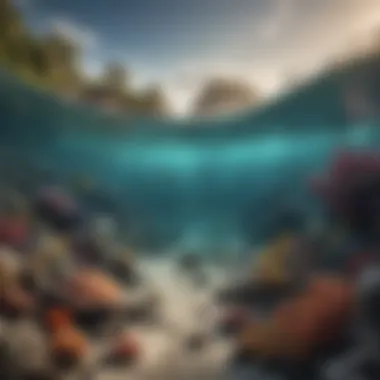

Predictive modeling has transformed how researchers approach oceanography. By utilizing historical data, scientists can forecast future ocean conditions and assess the implications of climate change. The most significant characteristic here is the ability to create simulations of complex ocean processes that inform policymakers and conservationists alike.
Though immensely valuable, these models come with disadvantages as they can be heavily reliant on the quality of input data. Poor data quality can lead to misleading results, thus affecting conservation efforts.
Collaborative platforms for data sharing
The growing emphasis on collaborative platforms has allowed oceanographers worldwide to share data like never before. This collaborative spirit not only increases transparency but drastically enhances the research quality through combined efforts and diversified expertise. Key to this development is the potential for faster, more comprehensive studies that set the stage for addressing global challenges.
However, one should note that data-sharing platforms can be susceptible to issues surrounding intellectual property and the varying standards of data collection, presenting challenges in establishing trust among collaborators.
The technological toolkit available to oceanographers today is a double-edged sword; while it enhances research, it also demands a higher level of expertise and collaboration than ever before.
Future Directions in Oceanography
The exploration of oceanography is not a static field; it continuously evolves as new technologies, research methodologies, and global challenges come into play. Understanding the future of oceanography is critical. It guides how we study our oceans, manage marine resources, and address environmental degradation, particularly in light of climate change. With countless undiscovered marine areas, evolving policies, and public education efforts, the future directions in this discipline are brimming with potential.
Emerging Research Areas
The study of deep-sea ecosystems
The deep sea is a realm often described as Earth's last frontier. Exploring these ecosystems sheds light on biodiversity that remains largely unknown. Recent advancements in submersible technology have made it possible to reach depths previously deemed inaccessible. The immense pressure and colder temperatures create unique adaptations among organisms found there. These ecosystems contribute to our understanding of genetic diversity. This is crucial for applications ranging from biotechnology to medical research.
One key characteristic of deep-sea studies is the potential discovery of novel species that could yield new compounds for pharmaceuticals. As a beneficial choice, deep-sea research could lead to advancements in environmental preservation and conservation strategies. However, the unique feature of deep-sea ecosystems brings challenges like the impact of deep-sea mining and its repercussions on fragile habitats.
Impacts of climate change on polar waters
Climate change is altering polar ecosystems at an alarming rate. This is not just an environmental issue; it's about understanding how these changes affect global systems. Polar waters are undergoing rapid shifts in temperature and salinity, which in turn impacts sea ice formation and the organisms that rely on it. These changes have far-reaching implications, including changes in global sea levels and weather patterns.
Polar studies illustrate a critical characteristic—the interdependence of ecosystems. This makes it a popular topic since the consequences of alterations in the Arctic can ripple through oceanic systems worldwide. The unique feature of this research lies in its urgency and necessity, given the imminent threats to biodiversity, climate feedback loops, and global currents. The disadvantages, however, include the costs and challenges of conducting research in harsh, remote environments.
Exploring unknown marine habitats
Despite advances in technology, a significant portion of Earth's oceans remains a mystery. Exploring unknown marine habitats is not only about discovering new species, but it also plays a crucial role in understanding ecosystem resilience. Many unknown regions are likely home to unique biological communities not yet under threat from human activity.
This research area is beneficial because discovering and documenting these ecosystems could provide crucial insights into marine biodiversity, conservation strategies, and the economic potential of marine resources. A unique aspect of these habitats is the possibility of uncovering natural resources or ecosystems that serve as climate change mitigators. However, the challenge lies in balancing the need for exploration with the potential adverse effects that human intrusion can cause.
The Intersection of Oceanography and Policy
Influence on international maritime law
With oceans covering over 70 percent of the Earth’s surface, international maritime law plays a crucial role in governing marine resources and ecosystems. The influence of oceanographic research directly feeds into policy-making, shaping regulations that protect marine areas from overfishing, pollution, and habitat destruction. It assists countries in understanding their maritime boundaries and rights to resources in international waters. The key characteristic of this relationship is the synergy between scientific evidence and legislative action. This combination can lead to faster, more effective policy responses to emerging coastal and oceanic challenges, making it a beneficial focus for sustainable management practices. However, one disadvantage is the often slow pace of policy change compared to the rapid deterioration of ocean health.
Management strategies for ocean conservation
The need for effective management strategies in ocean conservation has never been greater. Coordinated research and policy frameworks can lead to initiatives that protect marine habitats while allowing for sustainable use of resources. A core feature is the local governance of marine protected areas, ensuring that communities are involved in conservation efforts, which can boost the efficacy of such strategies.
Management strategies serve as a bridge between science and society, making them a critical element in boosting public engagement in ocean health. Their unique feature lies in their adaptive nature, allowing for adjustments based on ongoing research and changing ecosystem dynamics. Yet, there can be disadvantages due to conflicts among stakeholders over resource use.
Impact of oceanographic research on local policy
Oceanographic research does not exist in a vacuum; it has tangible effects on local policy decisions that can lead to sustainable practices. By providing data and evidence to local governments, researchers can influence regulations on fishing, pollution controls, and development practices in coastal zones.
A notable characteristic is how local policies can effectively implement community-led sustainability programs. The rise in local awareness about ocean health correlates with more robust conservation actions. However, one challenge is overcoming existing political structures and public skepticism regarding the science behind it.
Public Engagement and Education
The importance of ocean literacy
Ocean literacy is not just for scientists; it is vital for everyone. Improved understanding of oceanic processes among the general public can lead to more informed decision-making regarding marine and coastal issues. An informed population is more likely to engage in conservation efforts and support policies that protect ocean ecosystems.
The key characteristic of promoting ocean literacy is that it fosters a deeper connection to our marine environments. This makes it a popular choice for educational campaigns aimed at schools and communities. Unique features include interactive programs and technology-driven experiences, but a major disadvantage is the often limited funding for such initiatives.
Community involvement in marine conservation
When communities are involved in marine conservation, the results tend to be more effective and sustainable. Grassroots efforts often bring localized knowledge and a sense of ownership over marine resources, encouraging proactive engagement in conservation measures. This participatory approach harnesses awareness and commitment to protect marine environments.
One key aspect is the ability to leverage local knowledge, creating tailored conservation strategies suitable to different ecosystems. This is beneficial as it helps in rallying community support. The unique feature of this approach is the fostering of stewardship over marine areas; yet, disadvantages can arise when local interests conflict with conservation goals.
Resources for learning about ocean science
Access to resources is critical for expanding understanding of ocean science. From online platforms to community workshops, these resources empower individuals to deepen their knowledge of marine ecosystems. Availability and diversification of educational materials increase public engagement and support for conservation.
The importance of these resources lies in their potential to reach diverse audiences, making ocean science accessible to all. This is a beneficial choice for raising awareness about the oceans' health and dynamics. Unique features include various formats—video, workshops, and classrooms—which can engage different learning styles. Nonetheless, the challenge remains that not everyone has access to the internet or educational opportunities, potentially leaving gaps in knowledge.
End
In this concluding portion of our article, we address the overarching significance of oceanography both as a discipline and its implications for our world. The study of oceanography is not merely an academic pursuit; it serves as a vital tool for understanding the myriad complexities of our planet's oceans. Given that the oceans cover over 70% of Earth’s surface, they play a pivotal role in climate regulation, biodiversity, and the overall health of our ecosystems.
Recap of Key Concepts
As we reflect on the material we've traversed, several key concepts emerge.
- Interconnectedness of ocean systems: The physical, chemical, biological, and geological aspects of oceanography are deeply interconnected. For instance, ocean currents do not just shape marine weather; they also influence ecological zones by transporting nutrients vital for marine life.
- Impact of human activities: The significant environmental pressures, driven by human actions such as pollution and climate change, are increasingly threatening marine biodiversity and oceanic health.
- Technologies in research: The advancement in oceanographic technologies, from remote sensing to underwater robotics, is crucial for enhancing our understanding of these vast bodies of water.
"Understanding our oceans is fundamental not just for marine life but for human existence itself."
These points reiterate how oceanography intersects with numerous fields and underscores its relevance in today’s discourse.
The Path Forward in Ocean Conservation
Looking towards the future, the path in ocean conservation is riddled with challenges but also ripe with potential. Efforts to enhance marine conservation must pivot on a few key strategies:
- Community engagement: Involving local communities in conservation efforts fosters stewardship and amplifies the impact of protective measures.
- Policy reform: Effective legislation is paramount. Advancing laws aimed at reducing carbon emissions and protecting marine habitats can significantly offset some of the ongoing threats.
- Research collaboration: Collaborative efforts between scientists, policymakers, and educators can enhance overall ocean literacy and stimulate innovative solutions to pressing oceanic issues.
Investing in education around these areas can prepare future generations to tackle the challenges of ocean stewardship more successfully. With knowledge comes responsibility; as we learn more about the profound effects our actions have on the oceans, we can better strategize for a more sustainable future.



